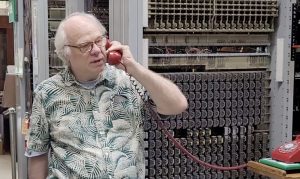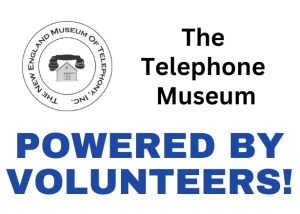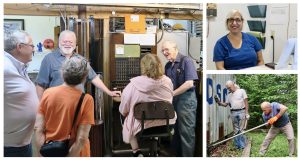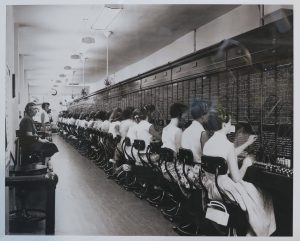
Martin Harriss of The Telephone Museum receives a call on the museum’s No. 5 Crossbar from Sarah Autumn of the Connections Museum in Seattle. Watch a video of the call, HERE.
The ringing of a telephone is a common sound at The Telephone Museum in Ellsworth, but that sound recently took on more significance.
On July 16, Sarah Autumn of the Connections Museum in Seattle called Martin Harriss of The Telephone Museum to mark 75 years since the No. 5 Crossbar, a telephone switching system that revolutionized telecommunications, was first placed into service in Media, Pennsylvania.
The call itself was made between “the only two preserved No. 5 Crossbar systems in the world,” said Martin, president of the board and a volunteer at the museum. It was facilitated by a VOIP connection on the internet.
“The call allowed us to celebrate the history and technological developments of the field of telephone switching,” he said. “It’s great to see them still working so well long after they were originally placed into service.”
The 5XB, designed by Bell Labs and built by Western Electric, was significant for a few reasons, Martin said.
“It was the first system where subscribers could dial their own long-distance calls. Previously, long-distance calls had to be completed with the assistance of an operator.”
“It was a very versatile system and was used for several purposes apart from basic telephone switching. The technical architecture of the system paved the way for later electronic and digital systems, including touch-tone calling.”
The No. 5 Crossbar system at the Connections Museum was installed on Mercer Island, Washington, in the 1950s, according to the museum’s website. It was moved to the museum after it was taken out of service in the 1980s.
The 5XB system now in Ellsworth originally went into service in Belfast, Maine, in 1964. “It served about 5,000 customers as the town’s telephone system until it was replaced by a modern digital central office,” Martin said.
Current museum treasurer Charlie Dunne and Charles Galley oversaw the acquisition of the system in the 1990s and its relocation to The Telephone Museum in Ellsworth.
“It took a number of years to piece the system back together and make it work,” Martin said. “Our first successful call took place on the morning of July 29, 2012. Since then, more work has been done to make more parts of the system work, such as making and receiving calls to and from our other switching systems.”
The challenging work of preserving technology like the 5XB is important, he said. “It’s part of the museum’s story about how we got from nothing to where we are today in the modern world of communication.”
To see the No. 5 Crossbar system in action, visit The Telephone Museum at 166 Winkumpaugh Road, Ellsworth. The museum is open from 10 a.m. to 4 p.m. Saturdays through September; other days by appointment or chance. Admission costs $10 per adult, $5 per child. Schedule your tour in advance by calling (207) 667-9491 or emailing switchboard@nemot.org. Include your name, best contact method, and the number of people in your party.
To support the museum’s efforts to preserve telecommunications history, volunteer or give online HERE.








